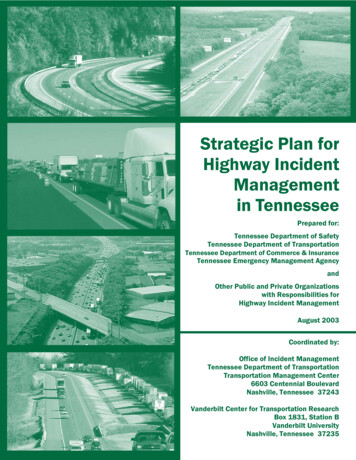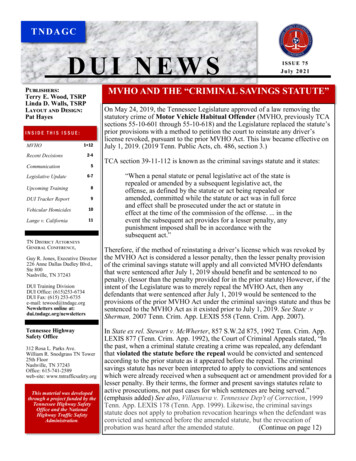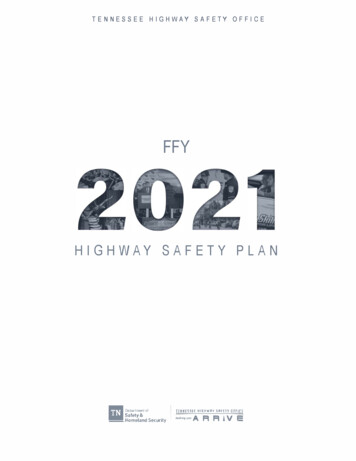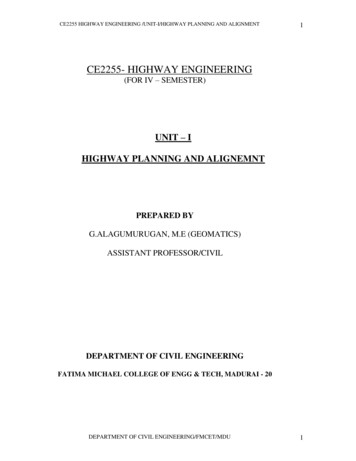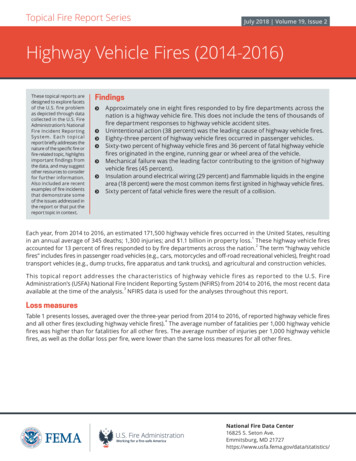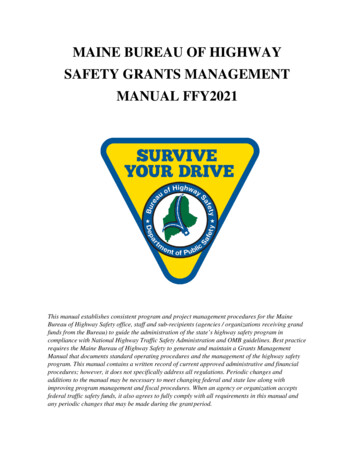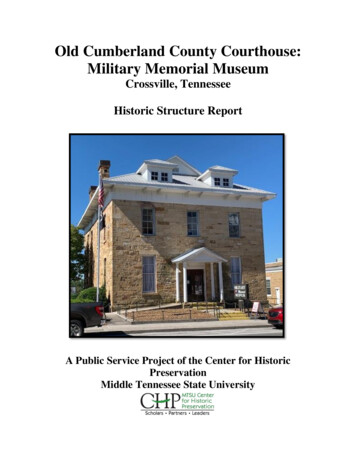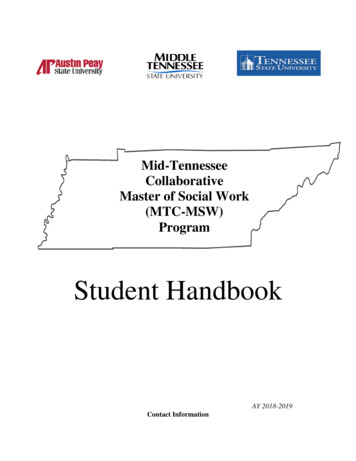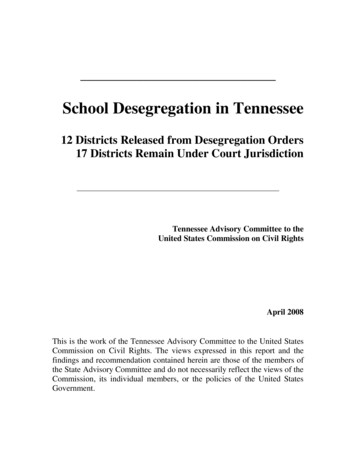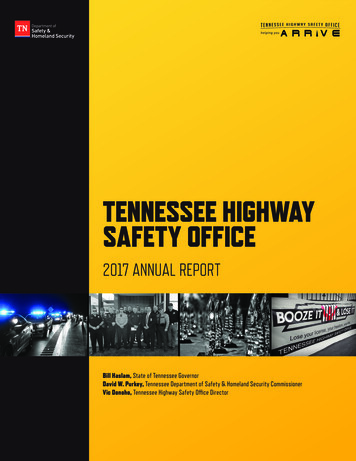
Transcription
TENNESSEE HIGHWAYSAFETY OFFICE2017 ANNUAL REPORTBill Haslam, State of Tennessee GovernorDavid W. Purkey, Tennessee Department of Safety & Homeland Security CommissionerVic Donoho, Tennessee Highway Safety Office Director
Table of ContentsTable of Contents . 1Abbreviation Explanation . 2Vision and Mission . 4Director’s Message . 5Fiscal Year 2017 Highlights . 7Performance Measures/Targets . 9Planning and Administration . 13Occupant Protection . 15Traffic Records . 24Alcohol and Other Drugs Countermeasures . 27Motorcycle Safety Program . 34Police Traffic Services . 38Law Enforcement Liaison Program. 48Network Coordinator Grants . 50Law Enforcement Training . 53Teen Traffic Safety Program . 56Distracted Driving . 60Senior Drivers . 63Pedestrian/Bicycle Safety. 67Emergency Medical Services . 70Paid Media . 73Earned Media . 87Legislative Update. 95Traffic Safety Partners. 96Evidence Based Enforcement Plan . 98Projects Not Implemented . 101Comprehensive Grant List. 102Appendix (no page numbers)Fiscal Review of Expended Funds
AbbreviationExplanationARIDEAdvanced Roadside Impaired Driving EducationATVAll Terrain VehicleCDCCenters for Disease ControlCEUContinuing Education UnitCIOTClick It or TicketCLIFCollegiate Life Investment FoundationCPSChild Passenger SafetyCPSTChild Passenger Safety TechnicianCRASHCrash Reduction Analyzing Statistical HistoryCTRThe University of Tennessee Center for Transportation ResearchDMVDepartment of Motor VehicleDVMTDaily Vehicle Miles TraveledDREDrug Recognition ExpertDUIDriving Under the InfluenceEMSEmergency Medical ServicesEVOCEmergency Vehicle Operator CourseFASTFixing America’s Surface TransportationFARSFatality Analysis Reporting SystemFFYFederal Fiscal YearGDLGraduated Driver's LicenseGMSSGrants Management Solutions SuiteHVEHigh Visibility EnforcementIACPInternational Association of Chiefs of PoliceIDTFImpaired Driving Task ForceLELLaw Enforcement LiaisonLIDARLight Imaging Detection and RangingMADDMothers Against Drunk DrivingMREPMotorcycle Rider Education ProgramTennessee Highway Safety Office2
NHTSANational Highway Traffic Safety AdministrationPOSTPolice Officer Standards and TrainingPTPolice Traffic ServicesRADARRadio Detection and RangingSADDStudents Against Destructive DecisionsSAFESeat belts Are For EveryoneSFSTStandardized Field Sobriety TrainingSTOPSStrategies and Tactics of Patrol StopsTCPSCTennessee Child Passenger Safety CenterTDOHTennessee Department of HealthTDOSHSTennessee Department of Safety and Homeland SecurityTDOTTennessee Department of TransportationTHPTennessee Highway PatrolTHSOTennessee Highway Safety OfficeTIMTraffic Incident ManagementTITANTennessee Integrated Traffic Analysis NetworkTRCCTennessee Traffic Records Coordinating CommitteeTRIMSTennessee Roadway Information Management SystemTSRPTraffic Safety Resource ProsecutorsVMTVehicle Miles TraveledYTDYear to DateTennessee Highway Safety Office3
Vision and MissionVISIONHave all highway users arrive at their destination and envision a time when there will be no fatalities onTennessee’s roadways.MISSIONTo develop, execute, and evaluate programs to reduce the number of fatalities, injuries, and relatedeconomic losses resulting from traffic crashes on Tennessee's roadways.Tennessee Highway Safety Office4
Director’sMessageI am delighted to present the 2017 Annual Report of theTennessee Highway Safety Office (THSO), which accounts forthe previous federal fiscal year’s activity, provides updatesregarding the state’s performance targets, and highlightsprogram accomplishments.This year has brought many exciting changes to the THSO andme personally. I joined the THSO on November 1, 2016, and Ihave learned a great deal about the office, its initiatives, itsprograms, and our many partners in law enforcement andwithin the community. As I traveled across the state, I wasdelighted to meet so many people committed to reducingcrashes and fatalities on Tennessee’s roadways and makingour state safer for all of its residents. With a fresh perspective,the management team and I have reviewed our processes andprocedures with an eye toward identifying efficiencies andopportunities for improvement. Throughout the year, the THSOhas continued to focus on its mission: preventing crashes andsaving lives.The THSO continued to examine long-time highway safety issues and emerging issues (drugged drivingand distracted driving) in an effort to determine innovative ways to address these safety concerns. Thisresulted in the THSO launching a new “Stop Drugged Driving” campaign and Tennessee’s first statewidedistracted driving enforcement bus tour to promote National Distracted Driving Awareness Month. Also,the THSO released its newest commercial entitled “Knock at the Door,” which received positive responsefrom law enforcement organizations across the country.The increased number of traffic fatalities in Tennessee remains a concern, despite our efforts to createsafer highways, increase public awareness, and support high-visibility enforcement of the state’s drivinglaws. Every traffic fatality is a tragedy, and many Tennessee families have experienced untold sufferingbecause of crashes that could have been prevented. This knowledge underscores the THSO’scommitment to traffic safety every day.Partnerships continue to play a critical role in our mission to reduce motor vehicle-related deaths andinjuries on our roads. We are committed to providing technical leadership, innovation, and programsupport to the THSO’s safety partners, and we continue to closely work with traffic safety advocates andorganizations, as well as the motoring public. In federal fiscal year 2017, 409 grants were awarded to365 different agencies, and our law enforcement partners have implemented safety programs that targetcrashes on our roadways. The expansion of predictive analytics continued in Federal Fiscal Year 2017Tennessee Highway Safety Office5
(FFY2017); this initiative helps improve the efficiency of resource allocation and improve the safety ofTennesseans when traveling on state roadways. Further, THSO participation in nationally and statesponsored enforcement campaigns remains high at over 99 percent in FFY2017.The THSO is proud of its history. In fact, 2017 marked our 30th Lifesavers Conference and the THSO’s50 years in highway safety. As the director of the THSO, it is clear that the many accomplishments listedin this report are the result of the partnerships between our office and the highway safety professionalsacross the state; each of them play a role in making Tennessee roadways safer for everyone.While we have made improvements in all areas of traffic safety, we still have much to accomplish in2018. Collectively, critical assessments, improved data collection, predictive analytics for enforcement,and data analysis all bode well for THSO’s future trajectory. I am eager to meet the challenges of makingTennessee highways safer this coming year.Vic DonohoDirectorTennessee Highway Safety OfficeTennessee Highway Safety Office6
Fiscal Year 2017HighlightsSeveral initiatives by the THSO, grantees, and traffic safety partners experienced success in FFY2017.The activities below are among the many additional accomplishments described in the report. Vic Donoho became Director of the THSO on November 1, 2016. A statewide Occupant Protection Coordinator was appointed this year, and a new OccupantProtection Task Force was created, with its first meeting this fall. The task force is chargedwith developing a strategic plan that is in alignment with Highway Safety Program GuidelineNo. 20. Active traffic enforcement promotes bothhighway safety and stopping criminal activity.An example of this is when the TennesseeHighway Patrol’s Sgt. Jimmy Jones and TrooperKevin Ballew made a traffic stop for speeding onHighway 30 in Van Buren County. Two Floridamen were in a rented Nissan Altima comingfrom Ohio to Florida when they were pulledover; they were driving at an estimated 80 milesper hour. The men were arrested when thetroopers found approximately 20 pounds ofmarijuana in their car. In July, Tennessee joined Alabama, Florida, Georgia, and South Carolina for OperationSouthern Shield to increase speed enforcement across the Southeast. The regionalmobilization took place from July 17 to July 23. During Operation Southern Shield, the THSOincreased speed-related messaging to promote awareness and education. The Lincoln County Sheriff’s Office has a longstanding commitment to highway safety under theleadership of Sheriff Murray Blackwelder. All of thedeputies are Advanced Roadside Impaired DrivingEducation certified, and there is one DrugRecognition Expert on staff. In FFY2017, theyhave seen a 17 percent decrease in injury crashes,a 14 percent decrease in crashes involving youthunder 18, and a 51percent increase inDUI/impaired arrests. Further, their commitment tothe grant includes education and awareness. Thisyear they conducted three safety seat checkpointsat local schools and have had approximately 1,000 citizens use their driving simulator.Tennessee Highway Safety Office7
Newbern Police Department’s Officer Danny Tippit was assigned tooversee the agency’s grant from the THSO last year. Since hisuncle’s death in 2014, Danny has been committed to traffic safety,providing training classes and programs to various civic groupsthroughout the community and neighboring counties. Since 2016,Newbern has seen a decrease in traffic crashes by 37 percent and a20 percent increase in DUI-related arrests. The THSO hosted its 30th annual Lifesavers Conference inMurfreesboro August 23-25, 2017, with over 750 registrants. Theconference also celebrated the 50th anniversary of the THSO. Governor Bill Haslam signed a proclamation declaring October 10 asPut the Brakes on Fatalities Day. Training was delivered to 158 prosecutors and 1,532 law enforcement officers through theTraffic Safety Resource Prosecutors (TSRP) through the Tennessee District Attorney GeneralConference. 1,752 law enforcement officers received training in highway safety subjects, all of which havebeen approved by the Police Officers Standards and Training (POST) Commission. Officer Larry Holladay consistently ranks at thetop of the Lavergne Police Department incitations and DUI arrests. He often volunteers towork overtime on checkpoints and the saturationgrant. In April, his colleague, Lt. Chris Goins ofthe Lavergne Police Department, stopped avehicle for a traffic infraction. Sometime duringthe stop, Lt. Goins became dizzy and just barelymade it back to his patrol car. Almostimmediately upon sitting down, he becameparalyzed and disoriented and was unable tocall for help. Officer Larry Holliday was not calledto the traffic stop but showed up as a courtesy. Upon arrival, Officer Holladay could tellsomething was wrong and immediately called for medical assistance. Lt. Goins was rushed tothe hospital, where it was determined that he had suffered a rare brain stem stroke. Lt. ChrisGoins made an astonishing recovery and is back to working full duty thanks to the quickactions of Officer Holladay. There was 99.33 percent participation in the THSO enforcement campaigns in FFY17. Colonel Tracy Trott of Tennessee Highway Patrol (THP) was named General Chair of theInternational Association of Chiefs of Police (IACP) State and Provincial Division, representingall state police organizations and provincial departments in the United States, Canada, andPuerto Rico. The Tennessee Highway Patrol conducted 307 sobriety checkpoints and 222 barchecks across the state. Further, 1,253 safety lectures were conducted. The THSO was one of four states awarded a drowsy driving grant from the GovernorsHighway Safety Association and The National Road Safety Foundation. The THSO partneredwith two organizations already engaging the public about the importance of safe driving:SADD Tennessee and TN Trucking Foundation. The drowsy driving prevention campaignreaches two key target populations—young drivers and commercial vehicle drivers.Tennessee Highway Safety Office8
PerformanceMeasures/TargetsThe following core outcome measures were established in the FFY2017 Tennessee Highway SafetyOffice Highway Safety Plan.TRAFFIC FATALITIESGoal: Decrease traffic fatalities by 1.55 percent from the 2014 calendar base year of 963 to 948 byDecember 31, 2017.Result: Based on Fatality Analysis Reproting System (FARS) data, Tennessee had 1,041fatalities in 2016.SERIOUS TRAFFIC INJURIESGoal: Maintain serious traffic injuries from the 2014 calendar base year of 6,868 to 6,868 by December31, 2017.Result: Based on state-level data, serious traffic injuries in Tennessee increased to 7,620 in2016.OVERALL FATALITIES/VMTGoal: Decrease fatalities/VMT from the 2014 calendar base year of 1.33 to 1.29 by December 31, 2017.Result: Based on FARS data, Tennessee decreased fatalities to 1.25 per 100 million VMT in2015, meeting the target.RURAL FATALITIES/VMTGoal: Decrease rural fatalities/VMT from the 2014 calendar base year of 1.79 to 1.61 by December 31,2017.Result: Based on FARS data, rural fatalities increased to 1.89 per 100 million VMT in 2015.URBAN FATALITIES/VMTGoal: Decrease urban fatalities/VMT from the 5-year alternative baseline average (2010-2014) of 1.022to 0.972 by December 31, 2017.Result: Based on FARS data, Tennessee urban fatalities decreased to 0.93 per 100 millionVMT in 2015, meeting the target.Tennessee Highway Safety Office9
UNRESTRAINED PASSENGER VEHICLE OCCUPANT FATALITIESGoal: Decrease the percentage of unrestrained fatalities by 7.06 percent from the 2014 calendar baseyear of 354 to 329 by December 31, 2017.Result: Based on FARS data, Tennessee had 336 unrestrained passenger vehicle occupantfatalities in 2016.ALCOHOL-IMPAIRED DRIVING FATALITIESGoal: Maintain alcohol impaired driving fatalities from the 2014 calendar year of 267 to 267 by December31, 2017.Result: According to 2016 FARS data, Tennessee had 223 alcohol-impaired driving fatalities,meeting the target.SPEEDING RELATED FATALITIESGoal: Decrease speeding-related fatalities from a 3-year alternative baseline average (2012- 2014) of219 to 209 by December 31, 2017.Result: According to 2016 FARS data, Tennessee had 183 speeding-related fatalities,meeting the target.MOTORCYCLIST FATALITIESGoal: Decrease motorcyclist fatalities from the 5-year alternative baseline average (2010-2014) of 130 to126 by December 31, 2017.Result: Based on FARS data, Tennessee had 147 motorcycle fatalities in 2016.UN-HELMETED MOTORCYCLIST FATALITIESGoal: Decrease un-helmeted motorcyclist fatalities from the 2014 calendar base year of 10 to 8 byDecember 31, 2017.Result: Based on FARS data, un-helmeted motorcyclist fatalities in Tennessee increased to13 in 2016.DRIVERS AGE 20 OR YOUNGER INVOLVED IN FATAL CRASHESGoal: Decrease drivers age 20 or younger involved in fatal crashes 16.52 percent from the 2014calendar base year of 121 to 101 by December 31, 2017.Result: Based on FARS data, Tennessee had 127 drivers under age 21 involved in fatalcrashes in 2016.PEDESTRIAN FATALITIESGoal: Reduce pedestrian fatalities from the 2014 calendar base year of 86 to 79 by December 31, 2017.Result: Based on FARS data, Tennessee had 97 pedestrian fatalities in 2016.Tennessee Highway Safety Office10
BICYCLE FATALITIESGoal: Maintain pedalcyclist fatalities from the 2014 calendar year of 5 to 5 by December 31, 2017.Result: Based on FARS data, Tennessee had 9 bicycle fatalities in 2016.OTHER BEHAVIOR PERFORMANCE MEASURESMeasureObserved seat belt useSeat belt citations issued by grant-funded agenciesImpaired driving arrests by grant-funded agenciesSpeeding by grant-funded agenciesSource: TN GrantsResult88.51%150,23425,260454,096Data in Annual Report: Where available, 2016 final FARS data is used for coreperformance measures. Unless noted otherwise, state data is provided by the TennesseeDepartment of Safety and Homeland Security, TITAN Division.Pictured from left to right:Front row: David Purkey, Rose Boyd, Shandi Smith, Sharmila PatelMiddle row: Kevin Hager, Vic Donoho, Beth Vernon, Jamie Wright, Deborah ScruggsBack row: Wm. Steven Harrison, Jason Ivey, Kim Van Atta, David McGriff, Terry HaganNot pictured: Joseph Waldrum, Arriale Tabson, Alexis Wright-DavisTennessee Highway Safety Office11
TENNESSEE HIGHWAY SAFETY OFFICEThe Commissioner of the Department of Safety and Homeland Security serves as the designatedTennessee Highway Safety representative, and the Director of the THSO fulfills the role of the state’scoordinator of the activity. The Tennessee Highway Safety Office employs a planning and administrationstaff of eight full-time state employees and 14 full-time University of Tennessee grant-funded employees.Tennessee Highway Safety Office12
Planning andAdministrationBehavioral highway safety programs require statewide coordination of many programs, employing fundsfrom several sources, and with overlapping regulations, objectives, and responsibilities. Planning andAdministration assists in the development, execution, implementation, and evaluation of highway safetyprograms statewide.GOALSGoals of the planning and administration program include the following: Administer the state and community Highway Safety Grant Program and other state andfederal-funded highway safety programs. Plan for coordinated highway safety activities utilizing resources strategically to decreasetraffic crashes, injuries, and deaths in Tennessee.PROGRAM OBJECTIVES AND RESULTSObjective: Produce required highway safety plans and performance documentation in a timely manner.Result: The Tennessee Highway Safety Office (THSO) prepared the FFY2018 HighwaySafety Plan and submitted it on time through NHTSA’s Grants Management Solutions Suite(GMSS) system.Objective: Deliver programs that effectively change knowledge, attitude, and behavior of Tennesseedrivers and others supporting our programs in reducing traffic crashes, injuries, and deaths.Result: The THSO developed and deployed effective traffic safety programs to educatedrivers and enforce state driving laws in order to reduce fatality crashes and injury crashes. Inresponse to the increase of speeding deaths within the Southeast, Tennessee joined NHTSARegion 4 partners in participating in Operation Southern Shield this summer. The THSOcontinues to educate the public through outreach along with paid and earned media. Thisyear, several print pieces were translated into Spanish to better serve the Hispanic population.Finally, the THSO continues to support and implement training for law enforcement, which isdetailed in the Training section of this report.Objective: Coordinate transportation safety, public safety, and injury control programs for theDepartment of Safety and Homeland Security and for the state of Tennessee.Result: The THSO continues to coordinate traffic safety and injury control programs withvarious traffic safety partners. For instance, several committees and stakeholders are involvedin the highway safety planning process. Tennessee receives input from the Traffic RecordsTennessee Highway Safety Office13
Coordinating Committee (TRCC), the Motorcycle Safety Coalition, and the Impaired DrivingTask Force (IDTF). This summer, the THSO launched a new Occupant Protection Task Force.The THSO also collaborated with the multiple agencies regarding the shared safetyperformance measures.Objective: Incorporate a competitive grant online application process into the development andimplementation of a portion of the FFY2018 Highway Safety Performance Plan.Result: The THSO instituted its online competitive highway safety grant application andevaluation process for FFY2018. The deadline for highway safety grant applications forFFY2018 funding was March 31, 2017. A total of 544 applications (307 programmatic and 237High Visibility Enforcement) were submitted to the THSO.ACTIONS TAKENThe THSO has been fully integrated into the Tennessee Department of Safety and Homeland Securitysince its transfer from the Tennessee Department of Transportation in April 2016. Staff completed itsoffice move in December 2016.Professional development and training of the THSO staff encourages employee engagement and createsgreater synergy across traffic safety programs. During FFY2017, the THSO staff members continuedtheir professional development through active participation in highway safety courses, participation inrelevant training events, and attendance at highway safety meetings and conferences.For instance, staff participated in Transportation Performance Management workshop through theFederal Highway Safety Administration. Staff also attended the national Lifesavers Conference,Governors Highway Safety Association’s annual meeting, SADD National Conference, and TrafficRecords Forum. Such experiences enhance staff skills and knowledge in establishing effective highwaytraffic safety program strategies.Further, several staff members presented at conferences as well. For instance, Rose Boyd, the THSO’ssenior driver coordinator, shared information about the Tennessee Safe Road for Seniors program at thenational Lifesavers Conference. Kevin Hager presented information about nighttime seat belt use at theNHTSA Region 4 LEL Conference, and Sharmila Patel spoke about the state’s bicycle and pedestrianinitiatives at the Tennessee Highway Safety and Operations Conference.Providing training for our grantees is another important responsibility. At the beginning of the grant year,multiple team members traveled across the state to lead grant orientation workshops. Staff membersplanned and moderated sessions at the state Lifesavers Conference, which is discussed in further detaillater in the report.Tennessee Highway Safety Office14
OccupantProtectionIncreasing seat belt and child restraint use is the simplest and most effective way to reduce seriousinjuries and death in the event of a motor vehicle crash. Tennessee’s occupant protection programaddresses and makes progress toward the goals and objectives listed below.GOALThe goal of the occupant protection program is to increase the statewide average safety belt use, reducethe rate of unbelted passenger occupant fatalities, and reduce the state misuse percentage of incorrectlyinstalled child passenger safety seats.PROGRAM OBJECTIVES AND RESULTSObjective: To increase the observed seat belt usage rate by 2 percent, from a 2015 baseline of 86.23percent to 88.23 percent in 2017.Result: For 2017, the final statistically adjusted statewide seat belt usage rate is 88.51percent ( /- 0.91 percent).Core Performance Measure: Decrease the percentage of unrestrained fatalities by 7.06 percent fromthe 2014 calendar base year of 354 to 329 by December 31, 2017.Result: Based on FARS data, Tennessee had 336 unrestrained passenger vehicle occupantfatalities in 2016.Objective To reduce the state misuse percentage of incorrectly installed child passenger safety seatsfrom a baseline of 82 percent in 2016 to 81 percent in 2017.Result: For FFY2017, the overall misuse rate of child passenger safety seats is 81 percent asreported by the Tennessee Child Passenger Safety Center (TCPSC) at Meharry MedicalCollege.The general goal of Tennessee’s occupant protection program is working to reach safety belt usage ratesat a level that is consistently at or above the national average. Efforts undertaken were designed toincrease awareness and adherence to Tennessee’s occupant protection laws with a priority given toenforcement and education. Partnerships have been built with representatives from law enforcementagencies, media, health professionals, education, and local civic organizations.Programming included enforcement activities, such as checkpoints and participation in nationalmobilizations. Public information and education activities were administered through mediaannouncements and support materials. Concentrated safety efforts included Click It or Ticket and BuckleUp in Your Truck.Tennessee Highway Safety Office15
AGENCIES FUNDEDDuring FFY2017, the Tennessee Highway Safety Office (THSO) funded several projects that specificallyaddressed child passenger safety and safety belts as seen in the following table. The occupant protectionprograms implemented by the THSO included education, enforcement, equipment, and evaluationcomponents. These programs were primarily conducted by partnering organizations that include localcolleges and universities, health departments, local enforcement agencies, hospitals and clinics, EMSand fire department personnel, and many of the state’s community programs related to injury prevention.AgencyBlount County Sheriff's DepartmentHamilton County Sheriff's OfficeKnoxville Police DepartmentLoudon County Sheriff's DepartmentMeharry Medical CollegeRoane County Sheriff's OfficeSevier County Sheriff's OfficeTennessee Department of Safety & Homeland SecurityTennessee Department of Safety District 1Tennessee Technological UniversityThe University of TennesseeWaynesboro Police DepartmentFundingSource405b402 / 405b405b405b402 / ideStatewideWayneFFY17 GrantAmount 10,000.00 125,000.00 9,957.63 10,000.00 400,000.51 10,000.00 10,000.00 100,000.00 10,000.00 159,618.22 195,162.51 10,000.00CHILD PASSENGER SAFETY PROGRAMThe primary goal of Tennessee’s occupant protection program is to promote and increase the use ofsafety belts and the proper usage of child safety systems by vehicle occupants. The TCPSC, whichoperates through a grant to Meharry Medical College, supports this goal as they and their partners planand implement statewide programs to train, certify, and re-certify Child Passenger Safety Technicians(CPST). The TCPSC also assists technicians in carrying out child safety seat checkpoints throughout thestate, and they interpret collected data to help develop improved educational materials and strategies.The ultimate goal is to promote the proper use of child restraint systems in all vehicles.The Tennessee Traffic Safety Center continues to provide educational resources to child passengersafety advocates throughout Tennessee. In addition, community members may request information viatelephone or electronically. Copies of some educational materials are provided at no cost to thecommunity. The rationale for this is clear; availability of up-to-date and relevant information is a keyfactor in solving the problem of unrestrained children.The TCPSC delivered interventions in four domains: Safety restraint misuse, Unrestrained children, Safety data collection, and Child Passenger Safety Technician certification and re-certification.Tennessee Highway Safety Office16
CHILD PASS
TDOT Tennessee Department of Transportation THP Tennessee Highway Patrol THSO Tennessee Highway Safety Office TIM Traffic Incident Management TITAN Tennessee Integrated Traffic Analysis Network TRCC Tennessee Traffic Records Coordinating Committee . the THSO released its newest commercial entitled "Knock at the Door," which received .
